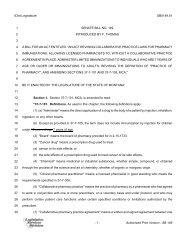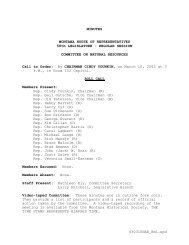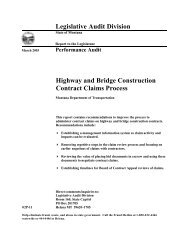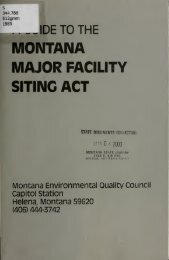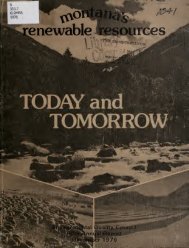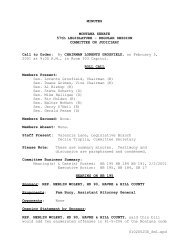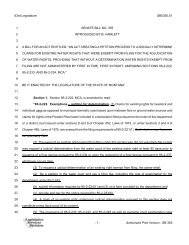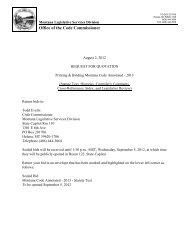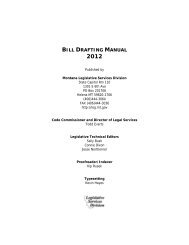Public Comment. Volume III - Montana Legislature
Public Comment. Volume III - Montana Legislature
Public Comment. Volume III - Montana Legislature
Create successful ePaper yourself
Turn your PDF publications into a flip-book with our unique Google optimized e-Paper software.
company by statute, in order to obtain access to<br />
private land for regulatory authorized use, with a<br />
court determining compensation under state law.<br />
What does an Easement Agreement Grant the<br />
Pipeline ?<br />
The easement agreement permits pipeline<br />
companies to construct, operate, maintain and<br />
patrol pipelines within certain boundaries on the<br />
property through which the easement has been<br />
granted. The area of land within these boundaries<br />
is referred to as the right-of-way.<br />
Can the Easement be Used for Anything Other<br />
Than the Pipeline?<br />
This is subject to negotiation. Easements can be<br />
negotiated for what ever purposes the parties<br />
mutually desire. A pipeline company can install in<br />
the right-of-way the necessary equipment for<br />
maintenance and operation of the pipeline, which<br />
includes, but is not limited to, fiber optic cables,<br />
cathodic protection equipment, test leads, and<br />
communications devices for sending and receiving<br />
signals, data and information. This is agreed to in<br />
the Right-of-way Easement Agreement with the<br />
landowner. If right-of-way easement is obtained<br />
through eminent domain, this equipment may only<br />
be used for the proposed pipeline and related<br />
facilities.<br />
What Type of Interest Can a Pipeline Company<br />
Obtain in a Property by Condemnation?<br />
The eminent domain statutes allow for either rightof-way<br />
easements or fee simple title to be taken.<br />
However, only the minimum necessary interest<br />
may be taken. A right-of-way easement is a<br />
sufficient interest for the purpose of buried oil<br />
pipelines. The <strong>Montana</strong> Petroleum Association is<br />
not aware of a single case in <strong>Montana</strong> where a<br />
crude oil or petroleum products pipeline company<br />
has ever condemned for title to the property.<br />
Do Crude Oil or Petroleum Products Pipelines<br />
Exercise the Right of Eminent Domain in <strong>Montana</strong>?<br />
By statute, common carrier crude oil and petroleum<br />
products pipelines have the right of eminent<br />
domain in <strong>Montana</strong>. While the right of eminent<br />
domain is necessary to ensure the viability of our<br />
energy delivery system, pipeline companies very<br />
rarely exercise their statutory right of<br />
condemnation. In order to balance public good<br />
with least private injury and just compensation,<br />
condemnation proceedings are complex and<br />
lengthy. Condemnation is used by pipelines only as<br />
a last resort, when right-of-way negotiations fail,<br />
and there is no other reasonable alternative. About<br />
1000 miles of crude oil and fuel products pipeline<br />
were built in <strong>Montana</strong> in the past decade. There<br />
were only two condemnation proceedings<br />
associated with all of that construction. Pipeline<br />
companies filed a few other condemnation lawsuits<br />
during the past decade; however, these were<br />
settled prior to trial.<br />
A condemnation proceeding can extend the<br />
amount of time required for obtaining approvals by<br />
an additional 2 years. If the condemnors are not<br />
allowed to obtain possession of the property until<br />
after the valuation process and valuation appeals,<br />
the time frame would be even longer. This<br />
extended time added to the negotiation process is<br />
not in the best interest of the public or the pipeline<br />
company, and every attempt is made to negotiate<br />
with landowners to avoid the use of eminent<br />
domain.<br />
The Safety Record of Crude Oil and Petroleum<br />
Products Pipelines<br />
U.S. Government statistics show that oil pipelines<br />
are the safest, most efficient method of<br />
transporting crude oil and petroleum products.<br />
Through the decade of the 1 990s, the average<br />
annual fatality rate associated with crude oil and<br />
petroleum products pipeline accidents in the United<br />
States was 2.2 lives per year. For comparison,<br />
42,524 people died in motor vehicle accidents in<br />
1997 in the United States.<br />
Government statistics also show that from 1990<br />
through 1999, less than two teaspoons of oil were<br />
spilled for each mile that one million gallons of oil<br />
traveled by pipeline. Pipelines carry sixty-five<br />
percent (65%) of all oil transported in the United<br />
C~de Oil & Petroleum<br />
Product Pipelines in <strong>Montana</strong><br />
Page 2<br />
-1 72- <strong>Volume</strong> Ill: <strong>Public</strong> <strong>Comment</strong>



